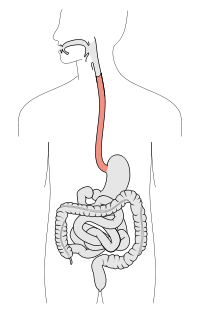
Photo from wikipedia
Introduction: Anal sphincter injury, mainly due to obstetric or iatrogenic etiology, is the most common cause of fecal incontinence (FI). Three-dimensional endoanal ultrasound (3D EAUS) is used for assessment of… Click to show full abstract
Introduction: Anal sphincter injury, mainly due to obstetric or iatrogenic etiology, is the most common cause of fecal incontinence (FI). Three-dimensional endoanal ultrasound (3D EAUS) is used for assessment of the integrity and the degree of anal muscle injury. However, 3D EAUS accuracy may be hampered by regional acoustic effects, such as intravaginal air. Therefore, our aim was to examine whether a combination of transperineal ultrasound (TPUS) and 3D EAUS would improve the accuracy of detection of anal sphincter injury. Methods: We prospectively performed 3D EAUS followed by TPUS in every patient evaluated for FI in our clinic between January 2020 and January 2021. The diagnosis of anal muscle defects was assessed in each ultrasound technique by two experienced observers that were blinded to each other’s assessments. Interobserver agreement for the results of the 3D EAUS and the TPUS exams was examined. A final diagnosis of anal sphincter defect was based on the results of both ultrasound methods. Discordant results were re-analyzed by the two ultrasonographers for a final consensus on the presence or absence of defects. Results: A total of 108 patients underwent ultrasonographic assessment due to FI (mean age 69 ± 13). Interobserver agreement for the diagnosis of tear on EAUS and TPUS was high (83%) with Cohen’s kappa of 0.62. EAUS confirmed anal muscle defects in 56 patients (52%), while TPUS confirmed them in 62 patients (57%). The final consensus agreed on the diagnosis of 63 (58%) muscular defects and 45 (42%) normal exams. The Cohen’s kappa coefficient of agreement between the results of the 3D EAUS and the final consensus was 0.63. Conclusions: The combination of 3D EAUS and TPUS improved the detection of anal muscular defects. The application of both techniques for the assessment of the anal integrity should be considered in every patient going through ultrasonographic assessment for anal muscular injury.
Journal Title: Diagnostics
Year Published: 2023
Link to full text (if available)
Share on Social Media: Sign Up to like & get
recommendations!